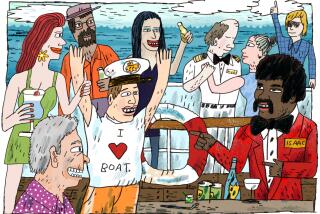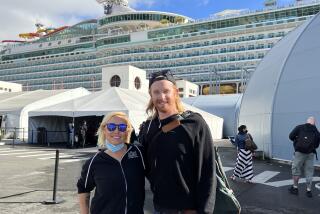Glut of cruise ships crowds the islands
- Share via
I returned to the Caribbean last month after several years and found some major changes, the biggest being the overwhelming effect of the cruise industry.
Some popular ports of call -- Charlotte Amalie on St. Thomas, U.S. Virgin Islands; San Juan, Puerto Rico; and Ocho Rios, Jamaica -- are being overrun with cruise ship tourists.
There are now so many 2,000-passenger cruise ships sailing in the West Indies that at least four or five of these behemoths are in the same port at the same time nearly every day of the week. They disgorge as many as 10,000 passengers in a single morning on the quiet lanes and shops of quaint Caribbean towns.
That unusual concentration affects the port cities (every day in winter, Charlotte Amalie is like a vast Wal-Mart) and the once-sleepy beaches and sightseeing attractions less than an hour’s drive from the port.
You arrive at a famous beach in the Virgin Islands, anticipating a quiet morning of snoozing and snorkeling, and suddenly several hundred cruise passengers emerge from buses to crowd you off the limited space. You snorkel above an underwater trail along coral reefs and you see as many human bodies as fish.
What does this mean for the savvy traveler?
Just as you avoid Florence and Venice in July and seek alternatives to Miami Beach in February and March, you must seek cruise itineraries featuring lesser-known ports or choose land vacations on islands visited by few cruise ships. Intelligent travel means moving against the flow.
Though I take second place to no one in my love of Old San Juan, I would not choose to be there when 12,000 cruise passengers descend on it. I’d decide instead to vacation in islands or locations receiving few cruise ships, such as Antigua, St. Kitts, Dominica or Grenada. If I chose to cruise the Caribbean in winter, I’d select the ships that stop in these little-visited places.
You enhance your chances of going to the lesser-visited islands by choosing a “lower Caribbean” itinerary. Most of these ships depart from crowded San Juan but sail to such destinations as Martinique or Curacao. These islands are so popular that they receive four ships a day.
If you decide to sail from a Florida port, you will probably go to the more heavily visited islands. But if you do some homework, you might be able to find ships sailing from Miami, Tampa, Fort Lauderdale or Port Canaveral that are routed off the beaten path.
Some lines are exploring new cruise destinations such as Roatan, off the coast of Honduras or a little-visited port that’s been created off the coast of Mexico south of Cancun called Costa or Riviera Maya. These stops will give you access to Maya ruins.
The more expensive cruise ships tend to sail to exotic, unspoiled islands.
Larry Fishkin, president of the cruise-and-tour company Leisure Link (www.eleisure link.com), said the elegant Seabourn, Crystal and Radisson cruise lines now frequently visit ports of Costa Rica or go to and through the Panama Canal, both relatively little-visited.
And the smaller wind-driven lines, such as Windstar Cruises or Clipper Cruise Line, wander through the lightly visited French Antilles, Nevis, St. Bart’s or Culebra, off the coast of Puerto Rico.
The Caribbean isn’t the only area suffering from an over-concentration of cruises.
On certain summer days, the number of cruise-ship passengers landing for the day at Ketchikan and Juneau, Alaska, exceeds the population of those two towns. The upcoming summer sailing season figures to be particularly bad, with many ships plying the route.
It’s an unavoidable condition with which we travelers must learn to contend.
More to Read
Sign up for The Wild
We’ll help you find the best places to hike, bike and run, as well as the perfect silent spots for meditation and yoga.
You may occasionally receive promotional content from the Los Angeles Times.






